This chapter focuses on the impact of legal and customary rights, regulations and practices on men’s and women’s access to and control over land in the Volta Region.
|
Topics discussed in this chapter are:
|
The study showed that access to land and control over land in the Volta Region was strongly determined by customary inheritance practices. These practices, which were largely determined by tradition (44% of responses; N=143), family heads (35%), and lineage/clan leaders (19%), generally favoured men over women.
The patrilineal system was the dominant customary inheritance system practiced in all the communities studied. As mentioned in chapter three, even families who had migrated to the Volta Region from regions where the matrilineal inheritance system prevailed, had adopted patrilineal inheritance practices.
Sixty percent (N=175) of the respondents pointed out that the patrilineal inheritance system vested greater land inheritance rights to men, whereas forty percent (N=121) indicated that men and women had equal land inheritance rights. The former statement was supported by the fact that few female respondents had actually inherited land. This was ascribed to the following reasons:
Land was seen as a priceless commodity and needed to be vested in men to assure the welfare and continuity of the descent group;
Women’s land rights needed to be restricted to avoid loosing family land upon marriage to someone from another clan or lineage;
Women had fewer opportunities to develop their own farms due to time constraints and financial constraints;
Land clearance was generally performed by men and enhanced their chances of initial land acquisition;
Lineage, clan and stool heads gave preference to people, usually men, who wished to cultivate cash crops because of the higher expected economic benefits; and
Wealthy farmers and multinational corporations from outside the communities were wiping out traditional land inheritance rights of men and women through the purchase of land in the Volta Region.
Men have historically determined traditions related to property distribution in the Volta Region and remain the dominant force in maintaining these traditions, as they are the main decision-makers in the Region. Therefore, changes to the customary inheritance system will strongly depend on men’s perceptions of the existing practices. Most of the respondents were satisfied with the inheritance system, although male respondents were more satisfied than female respondents. This is hardly surprising as the system clearly favours men over women.
Figure 6: Perceptions of the customary inheritance system applied (in %)

Source: WILDAF Study 2000
Eighty-four percent (N=99) of the male respondents and fifty-six percent (N=100) of the female respondents considered the system to be good. They explained that in their view everyone had equal access to family property because the system ensured equity and did not leave anyone out. A few respondents explained that the system was good although it was biased towards men. This was required to retain wealth within the family. Forty-four percent (N=80) of the female respondents and sixteen percent (N=19) of the male respondents indicated that the system could be improved and needed to be improved because it favoured men over women and children, whereas equality was required.
A comparison between the current inheritance rights of women with those of the past revealed that little had changed since independence (refer to figure 7).
Figure 7: Comparison between the current inheritance rights of women with those of the past (in %)

Source: WILDAF Study 2000
This was acknowledged by two-thirds of the respondents (N=196). Some explained that the system was fair and therefore there was no need for change, whereas others (mainly female respondents) indicated that no changes had been observed as the system still discriminated against women. Overall, it can be stated that male respondents had a more positive perception of the current inheritance rights of women compared to female respondents.
Respondents who indicated that women had obtained greater inheritance rights (N=62) ascribed this to the fact that: a) opportunities had increased for women to inherit property under their names, b) women had become more aware of their rights due to the passage of the Intestate Succession Law and c) there was an increased strive for gender equality. Respondents (N=35) who noted that women’s inheritance rights had worsened ascribed this to an increased discrimination against women. Seven respondents did not answer the question.
The exclusion of specific categories of women, such as childless widows, from land inheritance (as discussed in chapter four) was condemned by most respondents (N=197), especially female respondents[16]. Those who indicated that this practice was acceptable (N=83) ascribed it to the fact that family property had to be safeguarded. Twenty respondents did not answer the question.
Although most respondents opposed to the exclusion of categories of women from land inheritance, their exclusion did not seem to be significant enough to change existing land inheritance practices, as only one third of all respondents indicated that the current inheritance system could/needed to be improved (refer to figure 6). This shows how difficult it is to change existing practices, even if the communities are opposed to the practices.
Respondents were asked to share their knowledge of relevant legislation in Ghana, such as the Intestate Succession Law, the 1992 Constitution of Ghana, the Land Title Registration Law, the Head of Family Accountability Law and the Administration of Estates (Amendment) Law. The outcomes, reflected in figure 8, show that most respondents had limited knowledge of these laws, although men generally had more knowledge of the laws than women did.
Intestate Succession Law
The Intestate Succession Law was the best-known legislation among the communities studied. Twenty-two percent of the male respondents and thirteen percent of the female respondents had general or specific knowledge of the law. Some respondents indicated that the law had contributed to a certain level of awareness that discrimination against women and children are not permitted. A number of women had used their knowledge of the law to fight for their rights, whereas others mentioned that this law had had a positive impact on the ability of women to gain access to land and inherit land. However, 49% of the female respondents and 36% of the male respondents had no knowledge of the law.
When asked to indicate whether the Intestate Succession Law had been applied in cases familiar to the respondents where someone had died without making a will, almost two-thirds of the respondents (61%, N=183) indicated that this had not been the case. Traditional inheritance practices had been applied instead. One fifth (N=58) of the respondents indicated that the Law had been applied, whereas the others were either unaware of what had happened (N=34) or did not answer the question (N=25).
Drawing wills was not a common practice in the study area. Respondents explained that they had not drawn wills because: a) the household did not own enough property to make it worthwhile to draw a will, b) they were planning to do so in the near future, or c) they were still alive and not about to die. Only four percent of the respondents (N=12) had made wills. Most wills were made in written format with the remainder being oral wills.
Figure 8: Knowledge of relevant legislation affecting land in Ghana
Never heard of the law (in %)

Heard of the law (in %)

Knowledge of the law (in %)

Source: WILDAF Study 2000
The 1992 Constitution of Ghana
The 1992 Constitution of Ghana was the second best known law amongst the communities studied. Twenty-two percent of the male respondents and six percent of the female respondents had some knowledge of the Constitution. Most indicated that they had obtained their knowledge through radio programmes. It is striking, however, that 94% of the female respondents and 78% of the male respondents had no knowledge or had only heard of the 1992 Constitution of Ghana and therefore were probably unaware that it ascribes equal rights to men and women.
The Head of Family Accountability Law
The Head of Family Accountability law was the third best-known law among male respondents (17%), but known to only a few female respondents (6%). Four-fifth of the female respondents and two-thirds of the male respondents had never heard of the law. No further details were provided with regard to this law.
Land Title Registration Law
The Law that provides security of tenure to various types of landholders was relatively unknown among the communities studied. Fifteen percent of the male respondents and six percent of the female respondents had some knowledge of the Land Title Registration Law, whereas over two-thirds of the female respondents and almost half of the male respondents were totally unaware of it.
Land registration was not a common practice amongst the communities studied. Less than 2% of the household farm plots had been registered. Main reasons for not registering land were: a) a lack of knowledge on how to register land, b) no need to do so as it hadn’t been done in the past either, and c) the inability to register the land as the land did not belong to the person using it. Many respondents were of the impression that the existing system of property distribution provided sufficient security against interference. Traditional land demarcation practices, such as the planting of permanent trees or the construction of concrete poles on the borders of one’s land, were considered to be well functioning practices. Land title registration was generally considered to be a colonial legacy and people feared that the registration processes could result in re-demarcations and therefore an uprooting of traditional landmarks. In addition, it was revealed during the focus group discussions that many believed that family land only needed to be registered if it was to be used for building purposes and that family heads would not sign documents intended for registration because they would see it as an intuition of their traditional authority. Even though respondents who had completed secondary school had greater awareness of the law they were nevertheless usually unaware of the land registration procedures.
The Administration of Estates (Amendment) Law
The Administration of Estates Law was the least-known law among all the communities studied. Ten percent of the male respondents and five percent of the female respondents had some knowledge of the law. The law as relatively well known amongst the Anlo communities in the Southern zone because a number of families had gone to court to obtain letters of administration for the collection of pension benefits of a deceased relative.
In addition to the law-specific observations mentioned above, it was observed that:
Low levels of knowledge were striking in all the sub-regions and for all the laws discussed.
Knowledge of the laws was greater in areas where the laws had been applied.
The laws seemed to exist in name and on paper, and were not considered to be suitable alternatives to customary laws, as they were seldom applied to the benefit of communities in the Volta Region, despite the fact that the laws had the potential to enhance Individual and collective security of tenure over land.
Educated respondents who had completed secondary school had greater knowledge of the laws discussed above, probably due to their greater exposure to and understanding of their content.
The fact that both men and women had little knowledge of existing legislation affecting land and the 1992 Constitution of Ghana could mean that they are also unaware of other legislations, such as laws relating to child maintenance and marriage.
The main sources for obtaining information on statutory laws were electronic mass media (including TV[17] and Radio), interactions with friends, relatives and respected personalities (such as lawyers, assemblymen and village elders) and conversations on the streets.
A differentiation according to the sex of the respondent revealed that men obtained most of their information through electronic mass media (42%), whereas women obtained most of their information through interactions with relatives/friends and key persons, such as Queen Mothers[18], (44%) (refer to figure 9). This difference could be related to men’s greater access to and control over radio’s, televisions and other forms of electronic equipment and their greater amount of leisure time.
Men, women and children had obtained a lot of their information through radio programmes. Radios were commonly used, even in the remotest areas of the Region. Twenty-two percent (N=32) of the female respondents (N=32) and twenty-eight percent (N=39) of the male respondents indicated that they had obtained information about statutory laws through radio programmes. Six respondents indicated that they had become more aware of statutory laws either by attending court cases or by hearing about the court cases. This shows that an increased application of statutory laws can lead to an increased knowledge of the laws. Funerals were mentioned only once as an occasion during which information was obtained on statutory laws, although many respondents had received information through interactions with relatives and friends. These interactions could have taken place during funerals, as it is known that a lot of information is exchanged during funerals in the Volta Region. According to an Ewe saying: “One goes to a funeral not only to mourn but also to learn.”
Figure 9: Sources used to obtain information on legislation affecting land (in %)
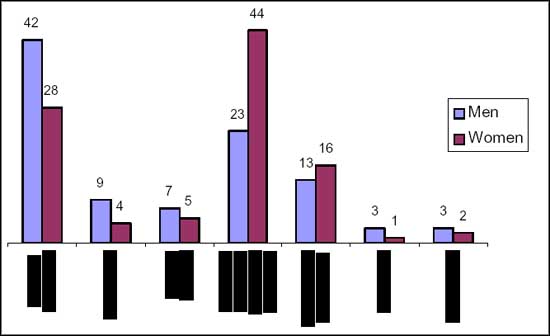
Source: WILDAF Study 2000
Other sources through which especially women had obtained information were: “Mmaa Nkomo,” the Federation of International Women Lawyers (FIDA)[19], and the SNV/WiLDAF Legal Awareness Programme implemented in the Volta Region[20].
It is interesting to note that eight percent of the female respondents had obtained information on land legislation through their husbands, yet none of the male respondents had obtained information through their wives. Therefore, any awareness campaign addressing women’s legal and human rights, needs to also focus on increasing the awareness of men with regard to women’s rights. A one sided approach could lead to an increased awareness of women of their rights but a lack of support and understanding amongst men, the main decision-makers in society, of the need to enhance women’s rights. Assembly Members, Chiefs, Queen Mothers and Village Elders can play an important role as information disseminators and agents of change agents in legal literacy programmes and other programmes that aim at addressing women’s rights.
Land disputes were common among all the communities studied[21]. This was acknowledged by almost two-thirds of the respondents (61%; N=176). Land disputes were especially common in the Keta district and less common in the Ho, Hohoe and South Tongu districts (refer to figure 10). Further research is required to clarify these differences. Most of the disputes evolved between siblings (47% of the responses) and between siblings and extended families (41% of the responses).
Figure 10: Occurrence of land disputes in the Volta Region
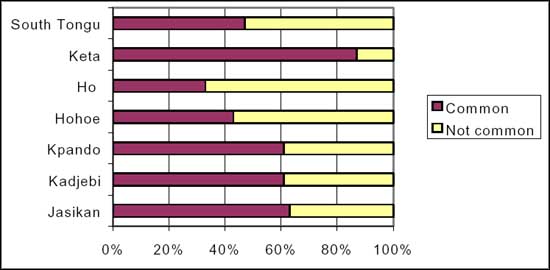
Source: WILDAF Study 2000
Most of the disputes were boundary disputes (46% of response (NT=179)), followed by ownership disputes (39% of responses) and access disputes (11% of responses). A differentiation according to sub-regions revealed that boundary disputes dominated in the Northern zone (55% of the responses) whereas ownership disputes dominated in the Central zone (48% of the responses) and Southern zone (44% of the responses) (refer to figure 11). These differences could be related to the greater demand for land in the Central and Southern zone due to higher population densities. There were no significant differences between the responses given by men or women with regard to land disputes. Both agreed that land disputes had a negative impact on men and women’s access to and control over land, as the land disputes restricted their land rights. Furthermore, it was acknowledged that land disputes had a negative impact on the agricultural production in the Region.
Figure 11: Type of land disputes
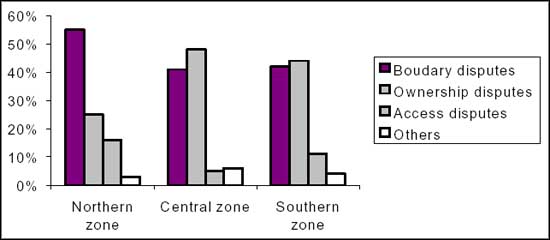
Source: WILDAF Study 2000
The small number of villagers who had registered their land was remarkable in view of the large number of land disputes in the Region. Further research is required to assess whether this is due to lack of awareness on how to register land, weaknesses of the procedures, a lack of funds, lack of control over the land, lack of trust in the land registration system or other reasons. An increase in land disputes can be expected if the population continues to grow (as has been predicted by the Ghana Statistical Service) and land registration remains an uncommon practice in the Volta Region.
State courts were accessible to all communities studied in the Volta Region. Eighty-seven percent of the respondents in the Southern zone, seventy-seven percent of the respondents in the Central zone and sixty percent of the respondents in the Northern zone noted a common use of the State court system within their communities. It is important, however, to note that only a small percentage of all disputes were solved through the State court system, as most disputes were solved by informal arbitration (i.e. using family elders, respected community leaders or specialists in arbitration) and customary methods of conflict resolution.
Men mainly used the courts although they were accessible to both men and women. Seventy six percent (N=208) of the respondents indicated that the courts were used by men, eighteen percent by both men and women and six percent by women. Few women used the State courts because it is a taboo for a woman in the Volta Region to challenge their husband or other male relatives in court. It was viewed that this action could result in a break-up of the marriage or the destruction of family relationships. Furthermore, women were often reluctant to go to court themselves because of the greater amount of time it takes to have a dispute settled by the State court as compared to traditional methods of conflict resolution. Bureaucracy in the legal system has resulted in a “give to God” (= fa ma Nyame) attitude among many women, thus effectively making them give up their rights. The number of cases included in the study where women used the court system was too small (N=12) to draw conclusions. Further research is required to gain greater insight on factors that withhold women from going to court.
The main reasons for going to court were to settle land disputes (N=171), theft issues (N=63), marriage matters (N=44), and quarrels/fights (N=41) (refer to figure 12).
Figure 12: Reasons for going to court
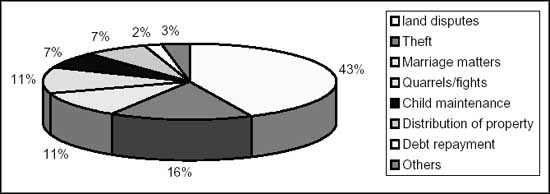
Source: WILDAF Study 2000
There are indications that although land disputes constituted the most common reason for going to court, only a fraction of all land disputes were settled in court. Most land disputes were settled through informal arbitration and customary methods of conflict resolution.
Figure 13: Reasons for not going to court
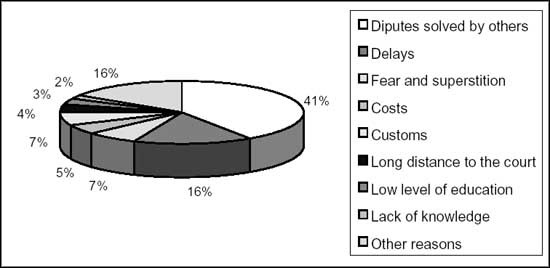
Source: WILDAF Study 2000
The main reasons assigned for low court attendance among both men and women were the fact that disputes were generally solved by others (N=55) and the fact that the court system was considered to be too slow (N=21) (refer to figure 13). Only five respondents mentioned the distance to the nearest court as a reason for not using the court system[22]. The study, however, revealed a greater use of State courts in communities where courts were located within a three kilometres vicinity of a court. The lowest percentage of court use was observed in the Kadjebi district. There were no significant differences in the responses given by male respondents and those given by female respondents.
Various programmes have been implemented in the Volta Region to increase men and women’s awareness of women’s legal and human rights. This has been done by organisations, such as WiLDAF and through radio and television programmes, such as Mmaa Nkomo. These programmes and other activities undertaken by locally respected persons (such as Religious Leaders, Village Leaders and Assembly Members) and local organisations have contributed to an increased awareness among men and women in the Volta Region of women’s rights and an increased assertiveness among women. For example, the Legal Awareness Programme (discussed on page 36) has increased the knowledge of men and women on the Intestate Succession Law, Marriage and Divorce Laws, the Making of Wills, the Children’s Act and violence against women. It was recommended to further expand the programme within the Region and to view the possibility of addressing land-related laws through the programme.
If statutory laws, which support equal rights for men and women, are to enhance women’s rights in the Volta Region, then an increased knowledge of the laws by both men and women is required as well as an increased utilisation of legal aid and other legal services by women. In addition, existing laws need to be reviewed from a gender perspective to determine whether they address the needs of men and women and whether they are easy to implement. If this is not the case, then the laws need to be adjusted or new laws need to be developed and funds should be made available for doing so.
|
[16] Seventy-nine percent of
the female respondents (NT=170) and fifty-seven percent of the male respondents
(NT=110) supported this statement. [17] One popular TV programme mentioned was “Mmaa Nkomo” (literally meaning discussions on women’s issues) [18] The important role of Queen Mothers in terms of disbursing information to women in the communities was highlighted during the focus group discussions. [19] FIDA is an association of women lawyers offering free legal services to women and children. [20] The SNV Netherlands Development Organisation/WiLDAF Legal Awareness programme became operational in the Volta Region in May 1998. Since then, over five hundred legal cases have been recorded in the Volta Region thanks to the work of a large number of Legal Literacy Volunteers (= people drawn from grassroot organisations, social groups, church groups, workplace associations, etc.) and Community Based Legal Educators. The programme focuses in particular on the Intestate Succession Law, Marriage and Divorce Laws, Wills, the Children’s Act and violence against women. The main goal of the programme is to create awareness and protect women’s rights through a legal education programme, improve access to legal services, increase awareness of women’s legal and human rights, and enhance the collection and dissemination of information on women’s rights. [21] An example of a land dispute that has been raging among the Abor community (Southern zone) for ten years concerned a plot of land that was to be used for the construction of a market. Construction was stalled because two lineages claimed ownership over the land. [22] The furthest distance to a court was observed amongst the communities studied in the Ho District (23 kilometres) followed by the Hohoe (5 km), South Tongu and Kadjebi (3km), Kpando (2km), Jasikan (1 km) and Keta (1 km). |